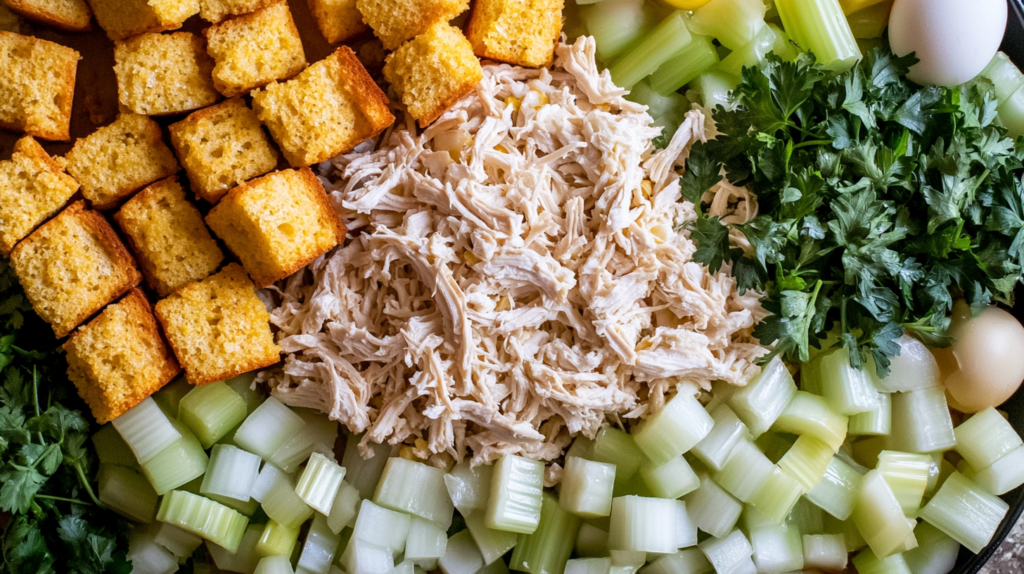Chicken dressing is a classic dish cherished in family dinners, holiday celebrations, and potlucks. Its rich, savory flavors and comforting textures make it a favorite side dish. Whether paired with roasted meats or served on its own, it always satisfies. But what exactly is chicken dressing, and why is it so popular?
At its core, chicken dressing is a baked blend of shredded chicken, bread, and seasonings. Herbs, vegetables, and broth enhance its flavor, creating a savory delight. Often associated with Southern cuisine, the dish has variations worldwide. Each region adds its own unique twist. Whether it’s for Thanksgiving or a simple cozy dinner, chicken dressing is versatile and easy to adapt.
This guide will walk you through every step to create the perfect chicken dressing. We’ll cover the key ingredients, substitutions, and preparation methods. You’ll also learn how to adapt the recipe for dietary needs and avoid common mistakes. To top it off, we’ll share serving ideas to make your dish shine.
Grab your apron and preheat your oven—it’s time to explore the world of chicken dressing. By the end of this guide, you’ll have everything you need to make this delicious classic in your own kitchen.
What is Chicken Dressing?
Definition and History
Chicken dressing is a savory, baked dish that combines shredded chicken, bread, vegetables, broth, and a variety of seasonings. While it is often mistaken for stuffing, the two are prepared and served differently. For instance, stuffing is cooked inside a turkey or chicken, whereas dressing is cooked separately, usually in a casserole dish. This distinction, however, is most commonly noted in Southern cooking, where the term “dressing” is preferred over “stuffing.”
For preparation techniques: Link to Cook Stuffing Before Putting It in the Chicken.
Historically, chicken dressing traces its roots to early European culinary traditions. In medieval times, cooks used bread, spices, and broth to create filling side dishes that complemented roasted meats. Over time, this practice made its way to America, where regional variations began to emerge. For example, Southern chicken dressing became popular due to its use of cornbread and robust, herbaceous flavors.
Today, chicken dressing has become a staple for special occasions, particularly during holidays like Thanksgiving and Christmas. Its hearty texture, deep flavor, and ability to pair beautifully with other traditional dishes—such as turkey, cranberry sauce, and gravy—have solidified its place in family celebrations across generations.
Variations Around the World
Although chicken dressing originated in European kitchens, it has evolved into a dish with countless variations around the globe. Each culture and region brings its own unique ingredients and preparation methods to the recipe. Let’s take a closer look at how chicken dressing is interpreted in different parts of the world:
- Southern United States:
In the Southern U.S., chicken dressing is most commonly made with cornbread as the base. This gives it a slightly sweet, crumbly texture. Additionally, celery, onions, sage, and chicken broth are used to create layers of flavor. Moreover, many Southern cooks incorporate buttermilk or cream to achieve a rich, moist consistency. - Europe:
In contrast, European cooking tends to feature crusty bread like baguettes or sourdough for its chicken dressing. Herbs such as thyme and rosemary are more prominent, while mushrooms and nuts, like chestnuts, are often included for added texture and depth of flavor. - Asia:
While chicken dressing isn’t traditionally part of Asian cuisine, modern adaptations have emerged. For instance, some Asian-inspired versions replace bread with rice or noodles. Furthermore, flavors like ginger, garlic, and soy sauce are introduced to give the dish an Asian twist. - Latin America:
In Latin American cuisine, chicken dressing often incorporates cornmeal or masa harina, which provides a texture similar to tamales. Ingredients like peppers, cilantro, and queso fresco further enhance the dish with vibrant and bold flavors. - Vegetarian and Vegan Adaptations:
Nowadays, there are many variations of chicken dressing that cater to vegetarian and vegan diets. For example, plant-based chicken substitutes and vegetable broth are used instead of traditional meat. Additionally, nutritional yeast or vegan butter can be added to mimic the savory depth of the classic recipe.
Why is Chicken Dressing So Popular?
There are several reasons why chicken dressing has gained widespread popularity over the years:
- Versatility: Chicken dressing can be customized in countless ways to suit different tastes and dietary needs. For example, whether you prefer a classic Southern version or a low-carb adaptation, this dish adapts effortlessly.
- Comfort Food Appeal: Its warm, savory flavors and hearty texture make chicken dressing a go-to comfort food, especially during the colder months.
- Perfect for Gatherings: Because chicken dressing pairs well with many dishes, it is ideal for holidays, potlucks, and family gatherings.
- Ease of Preparation: Although the dish may have many components, it is surprisingly simple to prepare. Most of the ingredients are pantry staples, and the process itself is straightforward. Therefore, even beginner cooks can achieve great results.

Key Ingredients for Chicken Dressing
A great chicken dressing begins with high-quality ingredients. While the exact recipe can vary depending on personal preferences or regional traditions, there are certain key components that are essential to achieving the perfect texture and flavor. Let’s break down these ingredients and explore some possible substitutions to customize the dish to your liking.
Core Ingredients in Chicken Dressing
1. Chicken
Shredded or chopped chicken is the heart of this dish. It provides the protein and a rich, savory flavor that complements the bread base. Most recipes use roasted, boiled, or rotisserie chicken for added depth. However, you can also use leftover chicken from another meal to save time.
- Pro Tip: Use chicken thighs instead of breasts for a juicier texture and more robust flavor. If you’re in a hurry, a store-bought rotisserie chicken works perfectly!
2. Bread
Bread is the foundation of chicken dressing, giving the dish its soft yet structured consistency. Traditional recipes call for cornbread, white bread, or a combination of both. The bread is usually dried or toasted before being crumbled, allowing it to absorb the broth without becoming mushy.
- Substitutions: For a gluten-free version, use gluten-free bread or cornbread. For a healthier option, try whole-grain bread or even cauliflower rice as a low-carb alternative.
3. Broth
Broth adds moisture and flavor to the dressing. Chicken broth is the most common choice, as it enhances the dish’s savory chicken flavor. You can use store-bought broth or make your own by simmering chicken bones with vegetables and herbs.
- Substitutions: For vegetarians, vegetable broth can be used in place of chicken broth. If you want a richer flavor, consider adding a splash of cream or milk to the broth mixture.
Enhancing Flavor and Texture
4. Vegetables
Onions, celery, and occasionally carrots are the classic vegetables used in chicken dressing. They add texture, flavor, and a touch of sweetness to balance the savory elements of the dish.
- Pro Tip: Sauté the vegetables in butter before adding them to the dressing mixture for a richer, more aromatic base.
5. Herbs and Spices
Sage, thyme, parsley, and black pepper are the cornerstone seasonings for chicken dressing. These herbs create the comforting and aromatic flavors that make the dish so appealing. Salt is also used to enhance the overall taste, but be mindful if your broth is already salted.
- Substitutions: For a unique twist, experiment with rosemary or marjoram. Fresh herbs provide a brighter flavor, while dried herbs offer convenience and longer shelf life.
6. Eggs
Eggs act as a binder, helping the dressing hold its shape during baking. They also contribute to a slightly creamy texture.
- Substitutions: If you prefer an egg-free recipe, consider using flaxseed meal mixed with water as a vegan binding agent.
7. Butter
Butter is used to sauté vegetables and to add richness to the dish. It creates a luxurious mouthfeel and enhances the overall flavor.
- Substitutions: For a dairy-free version, substitute butter with olive oil, coconut oil, or a vegan butter alternative.
Adapting Ingredients for Special Diets
If you have specific dietary needs or preferences, there are plenty of ways to modify the ingredients without sacrificing flavor or texture.
Low-Carb Option
Replace bread with cauliflower rice or a combination of almond flour and grated zucchini. This will reduce the carb content while maintaining a moist texture.
Gluten-Free Version
Use gluten-free cornbread, rice, or gluten-free bread crumbs. Be sure to check the labels of any store-bought broth to ensure it’s also gluten-free.
Vegetarian Adaptation
Swap the chicken with plant-based alternatives like shredded jackfruit, tofu, or store-bought vegan “chicken” substitutes. Additionally, use vegetable broth instead of chicken broth for a completely vegetarian-friendly dish.
Dairy-Free Option
Replace butter with olive oil or vegan butter. If the recipe calls for milk or cream, substitute it with almond milk, coconut milk, or another non-dairy alternative.
Key Ingredient Tips for Success
- Drying the Bread: Always use stale or oven-dried bread for the best results. Fresh bread can become too soggy when mixed with broth. To dry your bread quickly, cut it into cubes and bake it in the oven at 300°F (150°C) for 10–15 minutes.
- Seasoning: Taste the mixture before baking to adjust seasonings as needed. The flavors should be bold since some intensity will mellow during cooking.
- Broth-to-Bread Ratio: Add the broth gradually. You want it to hold together without being soupy.

How to Prepare Chicken Dressing?
Now that we’ve covered the essential ingredients, it’s time to dive into the step-by-step process of preparing a delicious chicken dressing. While the recipe may seem complex at first, breaking it down into manageable stages makes it simple and enjoyable. Below, we’ll cover everything from preparing the chicken to baking the final dish.
For other similar comfort food ideas: Link to Southern Cornbread Recipe.
Preparing the Chicken
The chicken is the star of this dish, so preparing it correctly is key to achieving the best flavor and texture.
- Choose Your Chicken:
You can use roasted, boiled, or rotisserie chicken. If starting with raw chicken, chicken thighs are an excellent choice because they remain moist and flavorful during cooking. - Cook the Chicken:
- For boiling: Place chicken in a pot of water with salt, pepper, and any aromatics (like garlic or bay leaves). Boil for 15–20 minutes, or until the chicken is cooked through.
- For roasting: Season chicken with olive oil, salt, and pepper. Roast in the oven at 375°F (190°C) for about 30–35 minutes or until fully cooked.
- Shred or Dice:
Once the chicken has cooled slightly, shred it into small pieces using a fork, or chop it into bite-sized chunks if you prefer a heartier texture. Set the chicken aside for later use.
Preparing the Bread Base
The bread base is what gives chicken dressing its signature texture. This step ensures the bread absorbs the flavors of the broth and seasonings.
- Dry the Bread:
If using fresh bread, cut it into 1-inch cubes and dry it in the oven. Spread the cubes on a baking sheet and bake at 300°F (150°C) for 10–15 minutes, or until they are slightly crisp but not browned. - Combine Cornbread and Bread Cubes:
If you’re using a combination of cornbread and bread, crumble the cornbread into a large mixing bowl and add the bread cubes. Stir gently to combine. - Season the Bread Mixture:
Add salt, pepper, and any dried herbs (like sage and thyme) to the bread mixture. This ensures the seasoning is evenly distributed.
Sautéing the Vegetables
Cooking the vegetables in butter or oil brings out their natural sweetness and enhances the dish’s flavor.
- Chop the Vegetables:
Finely dice onions, celery, and carrots (optional). - Sauté the Vegetables:
Heat a large skillet over medium heat. Add butter (or olive oil for a dairy-free version) and let it melt. - Season as You Cook:
Add a pinch of salt and pepper while sautéing the vegetables to help them release their natural flavors.
Mixing the Dressing
This step brings all the components together to create the perfect mixture for baking.
- Combine the Ingredients:
In a large mixing bowl, combine the bread mixture, shredded chicken, and sautéed vegetables. - Add the Broth:
Gradually pour chicken broth into the mixture while stirring. The goal is to achieve a moist but not overly wet consistency. Start with 2 cups of broth and add more as needed. - Incorporate the Eggs:
Beat 2–3 eggs in a small bowl and mix them into the dressing. This will act as a binder, helping the dish hold its shape during baking. - Adjust Seasoning:
Taste the mixture and adjust the seasoning. If it feels under-seasoned, add more salt, pepper, or herbs. Remember, the flavors will deepen as the dressing bakes.
Baking the Dressing
The final step is baking the dressing to golden perfection.
- Prepare the Baking Dish:
Lightly grease a casserole dish with butter or oil to prevent sticking. - Bake:
Preheat your oven to 375°F (190°C). Bake the dressing uncovered for 30–40 minutes, or until the top is golden brown and slightly crisp. - Check for Doneness:If it comes out clean and the top is set, the dressing is ready.
- Cool Slightly Before Serving:
Allow the dressing to cool for 5–10 minutes before serving. This helps the flavors meld and makes it easier to serve neat portions.
Pro Tips for Success
- Broth Consistency: Add the broth gradually. You want the bread mixture to be moist but not soggy. If you overdo it, add a bit more bread to balance the texture.
- Make Ahead: You can prepare the dressing mixture a day in advance. Store it in the refrigerator, then bake it fresh when needed.
- Double the Recipe: Chicken dressing freezes well, so consider doubling the recipe. Bake one batch for dinner and freeze the other for a future meal.

Frequently Asked Questions (FAQs) About Chicken Dressing
Here are some of the most commonly asked questions about chicken dressing, along with detailed answers to help you perfect this classic dish.
For complementary chicken recipes: Link to Chicken Yellow Rice Recipe.
1. What’s the difference between chicken dressing and chicken stuffing?
- Stuffing: Cooked inside the cavity of a turkey or chicken, allowing the juices to infuse the bread mixture during roasting.
- Dressing: Cooked separately in a casserole dish, resulting in a dish that’s easier to manage and bake evenly.
In Southern cuisine, the term “dressing” is often used regardless of where the dish is cooked, while “stuffing” is more common in other regions.
2. Can I make chicken dressing ahead of time?
Yes, chicken dressing is an excellent make-ahead dish. Here’s how:
- Prepare in Advance: Assemble the uncooked mixture and store it in an airtight container in the refrigerator for up to 24 hours.
- Bake When Needed: Remove it from the fridge about 30 minutes before baking to bring it to room temperature. Then, bake as directed.
3. What should I do if my dressing is too dry?
If your dressing turns out too dry, don’t worry—there are simple ways to fix it:
- Quick Fix: Drizzle warm chicken broth over the top of the baked dressing, then cover it with foil. Return it to the oven at 350°F (175°C) for 10–15 minutes to allow the liquid to soak in.
- Prevention: Ensure the mixture is adequately moist before baking. The bread should feel damp but not overly soggy when you add the broth.
4. Can I freeze cooked chicken dressing?
Absolutely! Cooked chicken dressing freezes very well and is perfect for meal prep. Here’s how to freeze it:
- Portion It Out: Divide the cooled dressing into portions and place them in airtight, freezer-safe containers.
- Label and Store: Label the container with the date and freeze for up to 3 months.
- Reheating: Thaw in the fridge overnight. Reheat in the oven at 350°F (175°C) for 20–25 minutes, or until warmed through. Add a splash of broth if needed to prevent dryness.
5. What are common mistakes to avoid when making chicken dressing?
To ensure your dressing turns out perfect, keep these tips in mind:
- Using Fresh Bread: Fresh bread can become mushy. Always use stale or oven-dried bread to maintain the ideal texture.
- Overdoing the Broth: Adding too much broth can result in a soggy mixture. Gradually add the broth until the bread is moist but still holds its shape.
- Skipping the Seasoning: Dressing relies on herbs and spices for flavor. Taste the mixture before baking and adjust the seasoning as needed.
- Baking Too Long: Overbaking can dry out the dressing. Keep an eye on it and remove it from the oven once the top is golden and set.
6. Can I make chicken dressing without meat?
Yes, you can easily make a vegetarian version of chicken dressing! Replace the chicken with plant-based alternatives like shredded jackfruit, tempeh, or store-bought vegan “chicken” substitutes. Use vegetable broth instead of chicken broth, and ensure the other ingredients align with vegetarian or vegan diets.
7. How long can I store leftover chicken dressing?
Cooked chicken dressing can be stored in the refrigerator for 3–4 days in an airtight container. Reheat individual portions in the microwave or larger portions in the oven at 350°F (175°C) until warmed through.
For longer storage, freezing is the best option. It will last up to 3 months in the freezer if properly sealed and labeled.
8. Can I use a store-bought rotisserie chicken for dressing?
Absolutely! Rotisserie chicken is a convenient and flavorful option. Simply shred the meat and use it as you would with homemade cooked chicken. The seasoning on the rotisserie chicken can even add an extra layer of flavor to your dressing.
9. What are some creative add-ins for chicken dressing?
While the classic recipe is delicious, you can add other ingredients to personalize your dish. Here are some ideas:
- Fruits: Add dried cranberries or diced apples for a sweet, tangy contrast.
- Nuts: Toasted pecans or walnuts add a crunchy texture.
- Cheese: Shredded cheddar or Parmesan can give the dish a creamy, savory boost.
- Spices: For a spicier kick, add a pinch of cayenne pepper or red pepper flakes.
Conclusion
Chicken dressing is more than just a side dish—it’s a beloved comfort food that holds a special place in homes and traditions across the world. Whether you’re preparing it for a holiday meal, a cozy family dinner, or simply to enjoy its hearty and flavorful profile, chicken dressing is a dish that never fails to satisfy.

